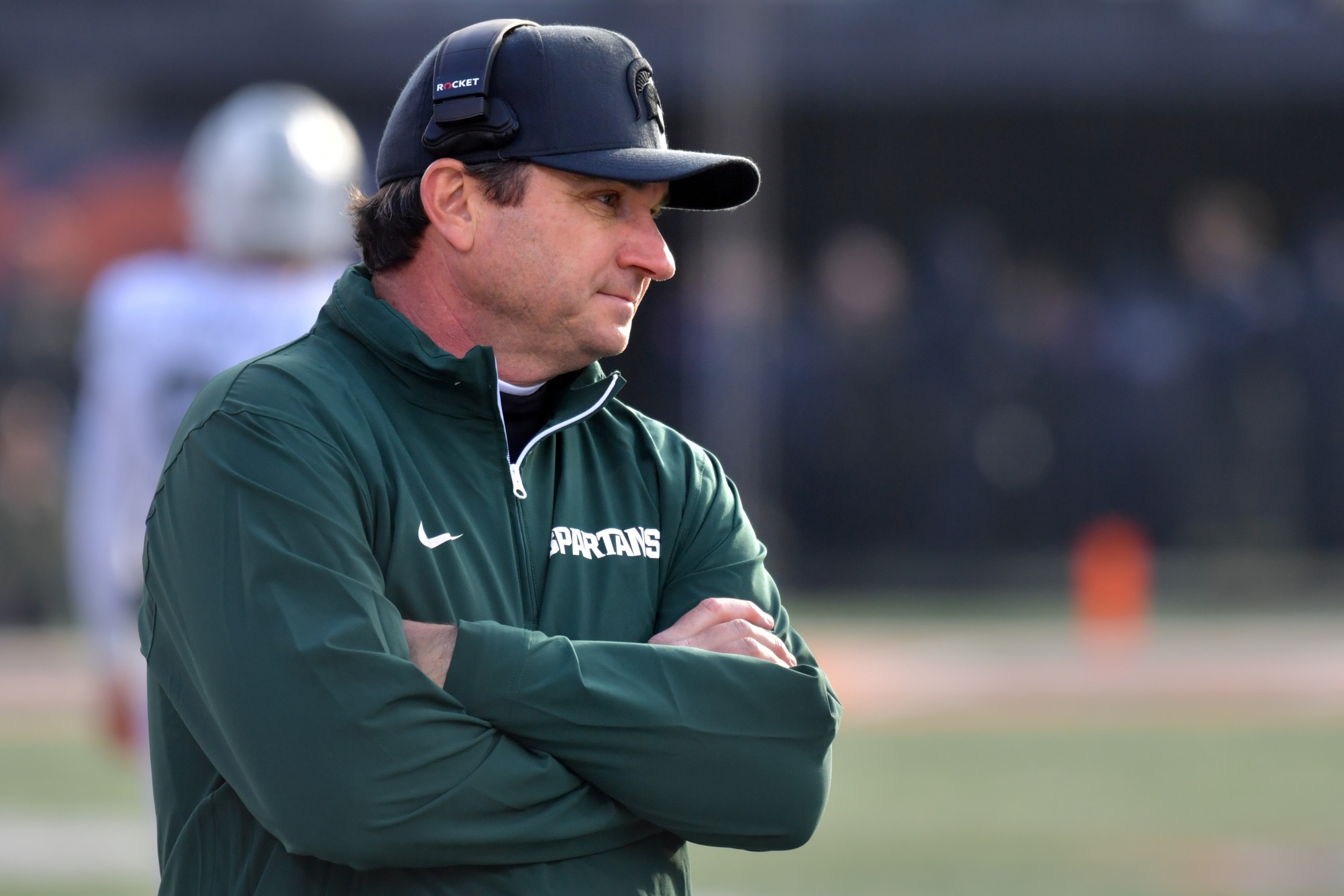Michigan State football began fall camp today as they prepare for the 2025 regular season.
Here are five questions facing the team in Jonathan Smith’s second season.
1. Can the Spartans find a running game?
It feels like we’ve been asking this question for a decade. And, aside from the Kenneth Walker III magic in 2021, the answer has been “no”. As a team, the Spartans averaged 3.5 yards per carry in 2024. Neither Kay-Ron Lynch-Adams nor Nate Carter eclipsed 700 yards, despite playing all 12 games. Michigan State ranked 14th or worse in the conference in yards per game, yards per carry, and rushing touchdowns.
Digging further into the numbers, it gets even more troubling.
In Big Ten play, MSU barely averaged 3.0 yards per carry. Against ranked teams, the Spartans averaged a meager 1.4 yards per rush, with a single rushing touchdown. And the numbers got worse as the season progressed. Over the final four games in November, MSU ran for just 2.4 yards per carry on over 30 attempts per game.
The running game was a staple of Jonathan Smith’s success at Oregon State. It’s also typically a strength for any successful football team at any level. And the impact of a reliable running game goes beyond the numbers.
There were countless occasions last season where Michigan State needed a yard and couldn’t get it. Other times, 1st-and-10 became 2nd-and-12. Drives stalled, and touchdown opportunities ended in punts or field goals. The absence of the running game also did little to help quarterback Aidan Chiles.
While Michigan State has some returning production along the offensive line, the bigger question is who they’ll be blocking for. Both Carter and Lynch-Adams have moved on to the NFL. Makhi Frazier, Brandon Tullis, Elijah Tua-Tolliver, and true freshman Jace Clarizio are all names to watch. This will be a good old-fashioned competition throughout August.
Michigan State football needs to find an answer at the position, along with a way to pound the rock in 2025.
2. Can Aidan Chiles take the next step?
Look, I’m aware that you could replace Chiles’ name in the question above with anybody on the roster. But the reality is that the 2025 Spartans have a capped ceiling unless they’re able to get more from their quarterback.
Some of it is our fault. We built Chiles into something that he was not ready to be in 2024. He was a young, growing quarterback with a flawed roster around him. MSU needed him to be the guy that made everyone better. On occasion, he did. But for the most part, he endured the struggles that plagued the rest of the team.
Chiles was inconsistent in 2024, and cost MSU with 11 interceptions and three lost fumbles. Too often, he extended plays beyond necessity. His downfield passes were consistently overthrown. And Michigan State’s intermediate passing game was practically nonexistent.
Now, it’s fair to point out that Chiles was working with a weak running game, a battered offensive line, and a true freshman as his top receiver. It was far from an ideal situation. And most of these miscues can be chalked up to a young player learning on the job.
But in his second full season as a starter, we need to see some growth. Mistakes will not be as easily forgiven. Because this roster should be improved. The Spartans added veterans Omari Kelly and Chrishon McCray to complement Nick Marsh at receiver. Jack Velling also returns at tight end. Young players along the offensive line should benefit from another offseason in the program. And this schedule should be more forgiving.
Make no mistake. Chiles is Michigan State’s quarterback. Nobody else on this roster can, or should, challenge him for snaps. Barring a catastrophe, he’ll be the Michigan State signal-caller for all 12 games.
But if he’s unable to show improvement, his status as the bonafide starter will be far less certain in 2026.
3. Can Michigan State find a pass rush?
Michigan State football found its way to the quarterback 19 times in 2024. On the surface, those numbers are below average. But when you consider seven of those sacks came in week one against FAU, it’s downright atrocious. In 10 games against Power Four opponents, the MSU defense tallied nine total sacks.
After getting to Boston College quarterback Thomas Castellanos four times on Sept. 21, the Spartans wouldn’t record a sack again until Nov. 22 against Purdue. That’s six consecutive games without a sack. Simply unacceptable.
By nature, Joe Rossi’s defense is not particularly aggressive. It’s a scheme designed to prevent big plays, and funnel throws underneath for minimal gains. In some regard, MSU’s low sack totals should be expected. At the same time, your defense needs to create some negative plays.
To make matters more challenging, a large chunk of MSU’s sack production is no longer with the team in 2025. The Spartans may have to get creative on defense to generate pressure. Because from afar, this roster looks light when it comes to pure pass rushers.
But that’s also the beauty of a new season. Opportunity knocks for several players. Joe Rossi and Smith may not know who their best defensive lineman and edge rushers are right now, but those players will emerge over the course of fall camp.
4. Can Brian Lindgren utilize Jack Velling?
Chiles grabbed all the headlines when he announced that he was following Smith from Oregon State to Michigan State. But Velling was seen as a big addition in his own right. And while his 2024 season wasn’t a total disappointment, it was fair to expect more.
This was a guy that scored eight touchdowns in 2023 while averaging over 15 yards per reception. Despite playing in all 12 games last season, it took Velling until the season finale against Rutgers to get into the end zone.
Offensive coordinator Brian Lindgren can’t allow that to happen again in 2025. Velling is too talented of a player to be utilized as infrequently as he was.
We’ve discussed MSU’s lack of playmakers on the roster in 2024. That likely made Velling an easier study for opposing defenses. But if the Michigan State offense improves, the rising tide should lift all boats. Ideally, Velling develops into a red zone weapon and a security blanket in the middle of the field for Chiles.
We didn’t see enough of that in 2024. At 6-foot-5, and 246 pounds, Velling has a shot to play in the NFL. But this is his last year of eligibility. It’s go time. We’ve seen him be productive in the past. But unlocking the next evolution would be massive for the Spartan offense.
5. Can Michigan State be more disciplined?
One of the reasons I thought Michigan State football would exceed expectations in 2024 was because of coaching. Under Mel Tucker, I always felt like the Spartans preparedness and execution of the fundamentals were average at best. Once he was fired, those two areas went into the toilet under the interim staff.
So, I thought Smith would be able to show improvement just by having the team ready to play with a renewed emphasis on the basics. But that didn’t really happen.
Michigan State was one of the most penalized teams in college football. They struggled mightily with turnovers, finishing -8 in margin on the season. The Spartans also finished outside the top 100 in red zone scoring percentage. They were the epitome of “one step forward, two steps back”.
Hopefully, a second offseason in the program helps fix some of those issues. Because at this point, Michigan State doesn’t have the talent to overcome those types of deficits in the margins.
I’m willing to hear some of the excuses. Lots of young players. Injuries. Typical year one headaches. But there is no excuse for those inconsistencies to carry over into 2025. MSU made life harder on themselves in 2024 by becoming their own worst enemy. Cleaning up the little things would be a huge step forward in 2025.

 FOOTBALL5 days ago
FOOTBALL5 days ago
 FOOTBALL4 days ago
FOOTBALL4 days ago
 MORE SPORTS1 week ago
MORE SPORTS1 week ago
 FOOTBALL1 week ago
FOOTBALL1 week ago
 BASKETBALL1 week ago
BASKETBALL1 week ago






